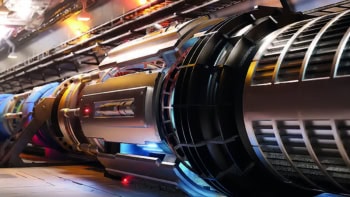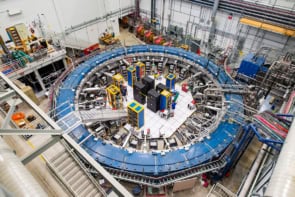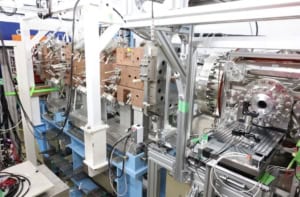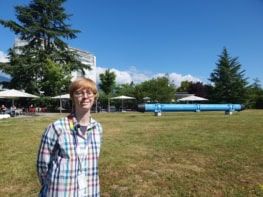Richard Blaustein talks to CERN director-general Fabiola Gianotti about how the lab is planning the next big experiment in particle physics beyond the Large Hadron Collider

Almost seven years after the discovery of the Higgs boson at CERN, how would you sum up the current state of particle physics?
We are at a very exciting time in particle physics. On the one hand, the Standard Model – the theory that describes the elementary particles we know and their interactions – works very well. All the particles predicted by the Standard Model have been found with the Higgs boson, which was discovered at the Large Hadron Collider (LHC) in 2012, being the last missing piece. In addition, over the past decades the predictions of the Standard Model have been verified experimentally with exquisite precision at CERN and other laboratories around the world. On the other hand, we know that the Standard Model is not the ultimate theory of particle physics because it cannot explain observations such as dark matter and the dominance of matter over antimatter in the universe and many other open questions, so there must be physics beyond the Standard Model.
Precise measurements of known particles and interactions are just as important as finding new particles
Is it concerning that the LHC has failed to spot evidence for particles beyond the Standard Model?
The discovery of the Higgs boson is a monumental discovery. It is one that has shaped our understanding of fundamental physics and has had an enormous impact not only on particle physics but also on other fields such as cosmology. We are now confronted with addressing other outstanding questions and this calls for new physics, for example, new particles and perhaps new interactions. We have found none so far, but we will continue to look. To improve our current knowledge and to detect signs of new physics, precise measurements of known particles and interactions are just as important as finding new particles.
How are you tackling this at the LHC?
The Higgs boson is related to the most obscure sector of the Standard Model, as the part that deals with the Higgs boson and how it interacts with the other particles raises many questions. So we will need to study the Higgs boson in greater detail and with increasing precision at current and future facilities, which could be the door into new physics. At the LHC, we are addressing the search for new physics on the one hand by improving our understanding of the Higgs boson and on the other hand by looking for new particles and new phenomena.

Europe unveils successor to the Large Hadron Collider
CERN recently released plans for the Future Circular Collider (FCC) – a huge 100 km particle collider that would cost up to $25bn. Given the huge cost, is it a realistic prospect?
We are currently studying possible colliders for the future of particle physics beyond the LHC. We have two ideas on the table. One is the Compact Linear Collider (CLIC), which would produce electron-positron collisions from 380 GeV – to study the Higgs boson and the top quark – to 3 TeV. The other is the FCC, a 100 km ring that could host an electron–positron collider as well as a proton–proton machine operating at a collision energy of at least 100 TeV. We are currently at the stage of design studies so neither of these projects are approved. At the beginning of next year, the European particle-physics community, which is updating the roadmap for the future of particle physics in Europe, will hopefully give a preference to one of them. Both CLIC and the FCC would be realized in several stages so that the cost will be spread over decades. As we push the technologies, which will also benefit society at large as the history of particle physics shows, we should also be able to reduce the cost of these projects.
Accelerators have been our main tool of exploration in particle physics for many decades and they will continue to play a crucial role also in the future
How might the FCC expand our knowledge of the Higgs?
The FCC as an electron–positron collider would allow us to measure many of the Higgs couplings – the strength of its interactions with other particles – with unprecedented precision. The proton–proton machine would complement these studies by providing information on how the Higgs boson interacts with itself and how the mechanism of mass generation developed at a given time in the history of the universe. Both machines combined would give us the ultimate precision on the properties of this very special and still quite mysterious particle.

Physicists await Japanese government decision on the International Linear Collider
Japan is expected to give some indication about plans to build the International Linear Collider (ILC) in March. If Japan goes ahead, would CERN get behind the ILC as the next big machine in particle physics?
The fact that Japan is considering building a linear electron–positron collider demonstrates that there is great interest in the study of the Higgs boson as an essential tool for advancing our knowledge of fundamental physics. If Japan decides to go ahead with the ILC, it will undertake negotiations with the international community – Canada, Europe and CERN, the US and other possible partners – to build a strong collaboration. In this case, the most likely option for CERN would be to build a proton–proton circular collider that is complementary to the ILC.
If Japan goes for the ILC and China opts to build its own 100 km Circular Electron Positron Collider (CEPC), is there a danger CERN would get left behind?
The ILC and the CEPC are both electron–positron colliders. We know that we also need a proton–proton collider, which would allow us to make a big jump in energy and search for new physics by producing possible new, heavy particles. The FCC proton–proton collider would have an ultimate collision energy almost a factor of 10 larger than the LHC and would increase our discovery potential for new physics significantly.

China unveils blueprint for huge underground ‘Higgs factory’
You are halfway through your term as director-general of CERN; what are your plans for the second half?
One major goal in the months to come for our community, including myself, is to update the European strategy for particle physics – a process that will be concluded in May 2020. We will have to identify the right priorities for the field and start preparing the post-LHC future. Accelerators have been our main tool of exploration in particle physics for many decades and they will continue to play a crucial role also in the future. The outstanding questions are compelling and difficult and there is no single instrument that can answer them all. For instance, we don’t know what the best tool is to discover dark matter. It could be an accelerator, an underground detector looking for dark matter particles from the intergalactic halo, a cosmic survey experiment or something else. Thus, we have to deploy all of the experimental approaches that the scientific community has developed over the decades and accelerators have to play their part.
Collaborations in particle physics are getting larger and larger sometimes consisting of thousands of scientists, do you think there is a danger of “group think”?
Collaboration is very much in the DNA of particle physics. CERN brings together 17,000 physicists, engineers and technicians from more than 110 different countries around the world. Collaboration is fundamental because the type of physics we do requires instruments such as accelerators, detectors and computing infrastructure that no one single country could ever realise alone. So we need to pull together the strengths, the brains and the resources of many countries to be successful in this endeavour. Small projects can obviously also do great science, but the Higgs boson, gravitational waves and neutrino oscillations could not have been discovered by small experiments conducted by small groups. Both small and big projects are needed, it depends on the question you want to address.
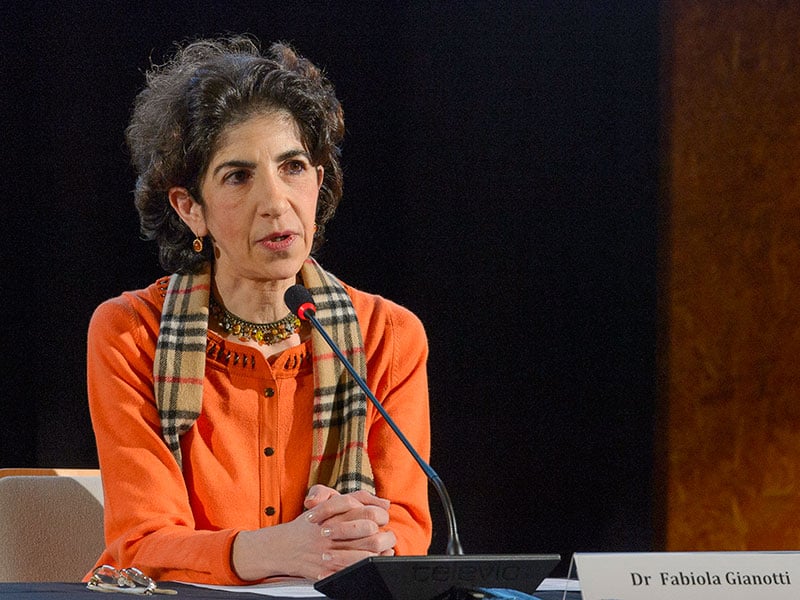
Fabiola Gianotti takes charge at CERN as lab weighs up designs for future colliders
What role can science diplomacy play in today’s turbulent times?
Science can play a leading role in today’s fractured world because it is universal and unifying. It is universal because it is based on objective facts and not on opinions – the laws of nature are the same in all countries. Science is unifying because the quest for knowledge is an aspiration that is common to all human beings. Thus, science has no passport, no race, no political party and no gender. Clearly, places like CERN and other research institutions cannot solve geopolitical conflicts. However, they can break down barriers and help young generations grow in a respectful and tolerant environment where diversity is a great value. Such institutions are brilliant examples of what humanity can achieve when we put aside our differences and focus on the common good.
